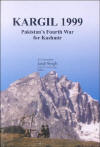|
| Home | About Kashmir Herald | |
Volume 2, No. 1 - June 2002 |
|
|
|
Jamiat-ul-Mujahideen (JUM) The Jamiat-ul-Mujahideen (JUM) was the first breakaway faction of the Hizb-ul-Mujahideen (HM) that emerged out of a personality clash between Master Ahsan Dar, the then Chief of the outfit and Hilal Ahmed Mir. Mir, who used the code-name Nasirul Islam opposed the move to transform the Hizb into Jamaat-e-Islami's armed wing. It was formed in 1990 with Sheikh Abdul Basit as its Chief. Its followers are mostly Kashmiris from the Ahle Sunnat (Deoband) school. The JUM is organised along military lines and a political Amir heads the organisation. It has a ‘commander-in-chief’ and a ‘vice commander-in-chief’ who commands four ‘divisional commanders’ who in turn command the various ‘district commanders’ and ‘area commanders’. According to recent news reports, Engineer Mohammed Salah is said to be the ‘Chief Commander’ of the outfit while Col. Shamas is one of the important ‘District Commanders’. It publishes a monthly magazine Mahaz-e-Kashmir in which it enumerates its terrorist operations systematically. Unlike the other terrorist organisations who draw support along sectarian lines, the outfit recruits terrorists from all sects. But, it has not been able to grow into a larger outfit. The Jamiat-ul-Mujahideen played a significant role in the early years of militancy in Jammu and Kashmir. However, it has not been able to maintain its momentum, despite remaining active in several parts of the State over the years. The cadre strength of the outfit is currently reported to be in hundreds. Many of its cadres are still in detention. Several JUM leaders were killed in a series of encounters after 1996, leaving its cadre disorganised and increasingly fragmented. The Jamiat-ul-Mujahideen considers itself as being a ‘pure’ Kashmiri organization and according to the leadership, all other terrorist outfits have either been suppressed or have accepted Pakistani-recruited cadres in their midst. However, recent reports indicate that as the inflow of Kashmiri youth from Jammu and Kashmir is decreasing, the JUM now needs to recruit Pakistani youth into its ranks. A senior J&K police official said in April 2001 that the top ‘commanders’ of the Jamiat-ul-Mujahideen had been arrested and the security forces were close to busting the entire outfit. The Jamiat-ul-Mujahideen is opposed to the All Parties Hurriyat Conference (APHC) whom Abdur Rafeh, a senior leader of the outfit described as a big danger for the terrorist movement in Jammu and Kashmir. According to him, the APHC is an obstacle in the way of the imposition of Islamic laws in the State. The Hurriyat, according to the JUM, has no right to represent the terrorists in Jammu and Kashmir. The outfit has come out strongly against the recent peace initiatives of both India and Pakistan as it considers violence as the only means to settle the Kashmir issue. The JUM also supports the accession of Jammu and Kashmir with Pakistan. The JuI had also termed the surrender of Hashim Qureshi, who had hijacked an Indian Airlines flight to Lahore in 1971, as "an act of treason'' and also threatened to "take him to task''. Maulana Ghulam Rasool, alias ‘General’ Abdullah alias Mohammad Ramzan Sofi, a native of Kupwara, who escaped from a Srinagar jail in February 3, 2000, is running their operation in Pakistan. He had earlier been arrested from Gow Kadal, Srinagar, in 1997 for charges including the triggering of an Improvised Explosive Device (IED) at the Gupkar Road, adjacent to the Jammu and Kashmir Chief Minister Farooq Abdullah’s residence, in January 1997. Six persons were killed in the blast. He was reportedly on the list of detained terrorists whom the hijackers of the Indian Airlines flight IC 814 wanted to be set free in exchange for the hostages at Kandahar in December 2000. He had first been arrested in 1993, and during the next seven years, was arrested twice more. But on each occasion, Ghulam Rasool has managed to escape. Along with Nasirul Islam, he had formed a group called the Shabab-ul-Islam with a view to introduce the ideas of ‘freedom’, ‘rights’ and jihad among the Muslim youth of Jammu and Kashmir. The Shabab-ul-Islam culminated in the formation of the Jamiat-ul-Mujahideen. In 1991, the outfit was allegedly involved in the killing of Mohammed Sayeed, Joint Director in the Information Department. It is also suspected to have been involved in the killing of H N Wanchoo, a human rights activist in December 1992. The JuI was also reportedly responsible for the Badami Bagh cantonment blast in March 1993 in which 29 persons were killed. The expertise of the outfit is reported to be in carrying out grenade attacks and explosions. A cadre of the Jamait-ul-Mujahideen, who was part of the fidayeen (suicide) squad that infiltrated into the Army battalion headquarters at Beerwah in Budgam district and launched an attack on forces inside the camp on September 12, 2000, was consequently killed in an encounter. With the arrests of a JUM terrorist Muzzafar Mirza and his associates in Srinagar and of Nissar Ahmad Gandroo in Kolkata on January 10, 2001, the police foiled their plans to launch terrorist attacks on the eve of Republic Day. Nine people, including four security force personnel, were killed in an explosion outside the local Army Headquarters at Batwara in Srinagar, on December 25. Although the Jamiat-ul-Mujahideen reportedly claimed responsibility for the attack, security forces suspected that the explosion was a joint effort of the Jaish-e-Mohammed (JeM) and another terrorist outfit, the Al-Umar. Courtesy: |
 |
 |
 |
|
| Archives
| Privacy Policy |
Copyrights
| Contact
Us | |
||